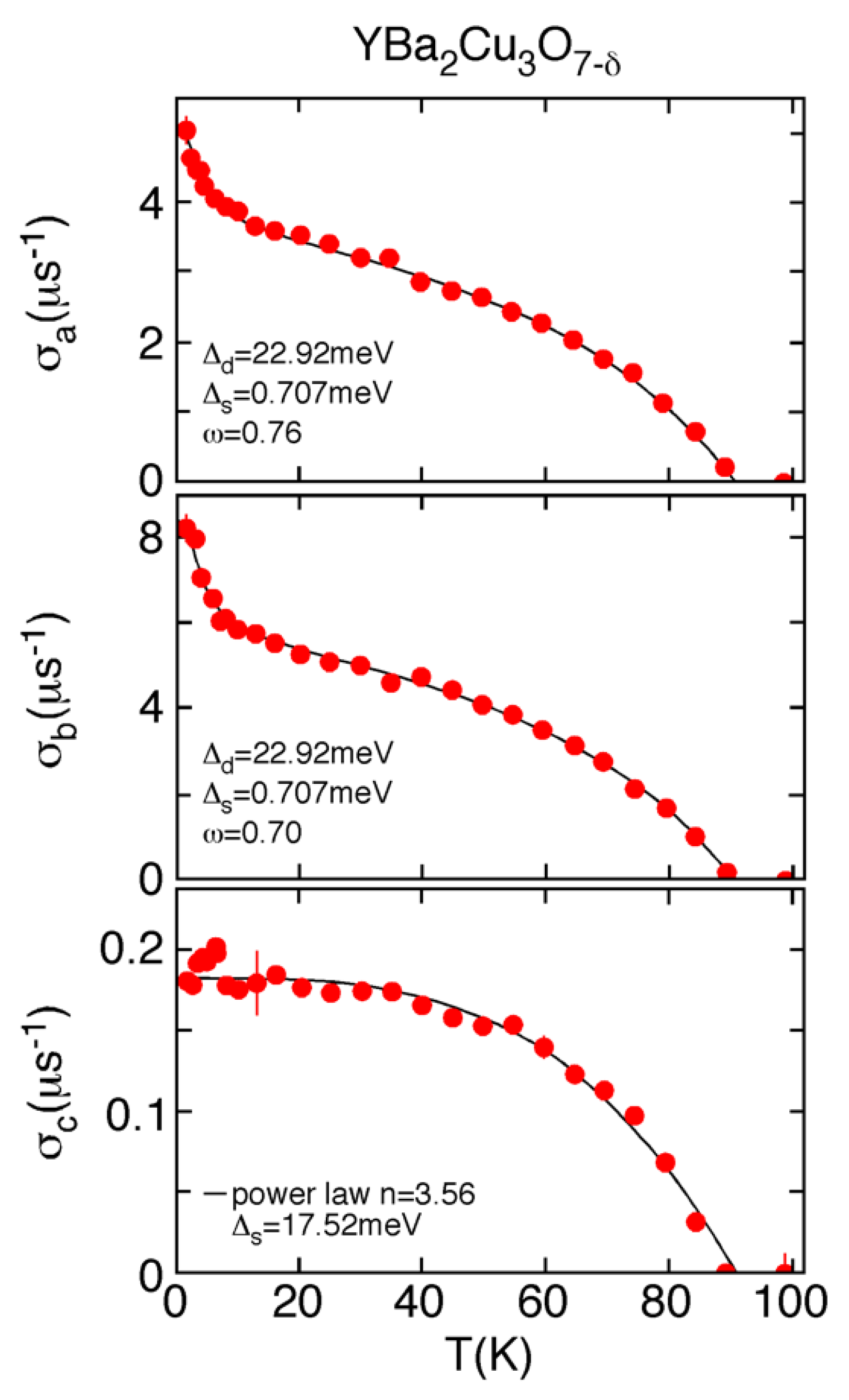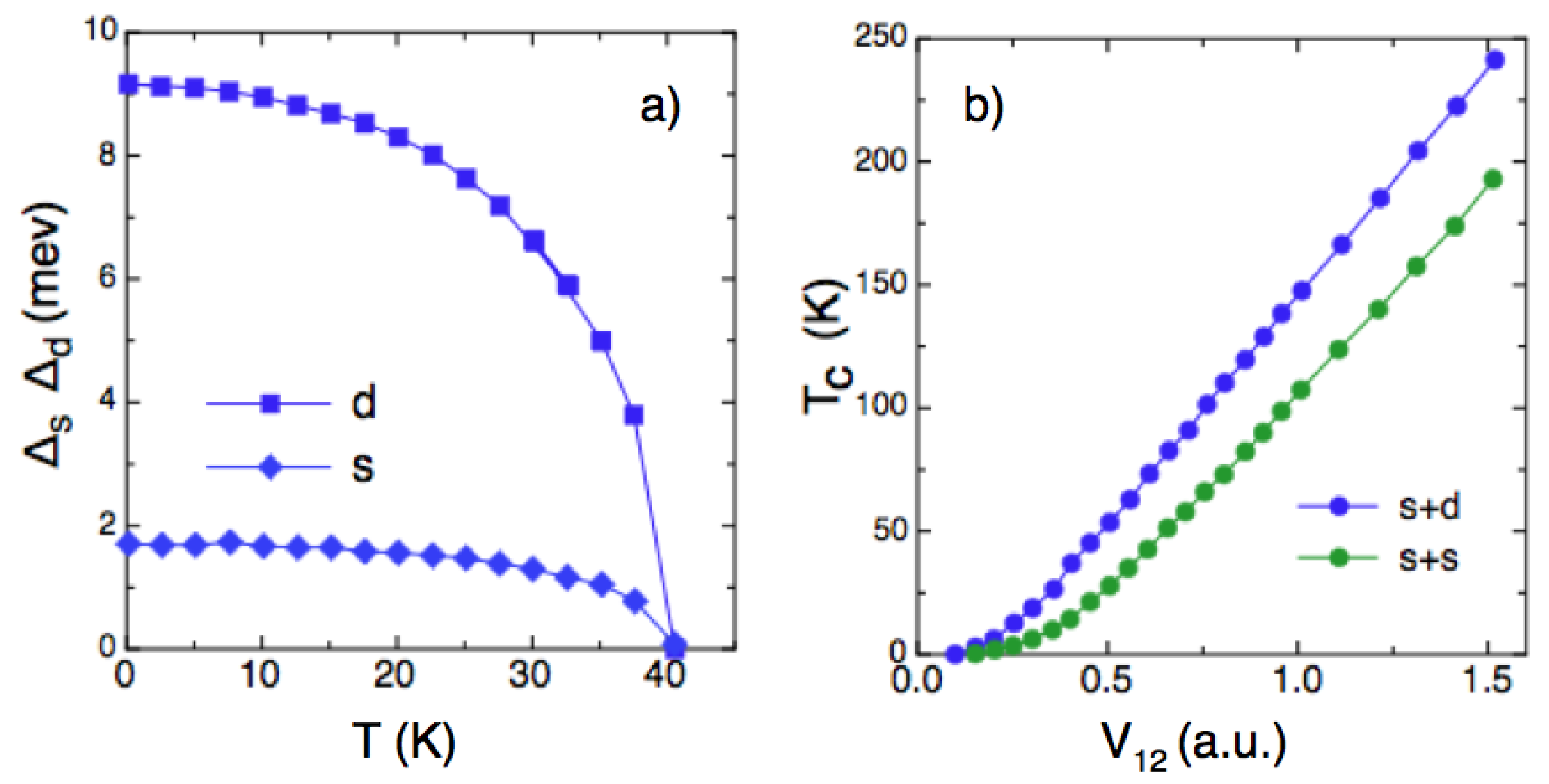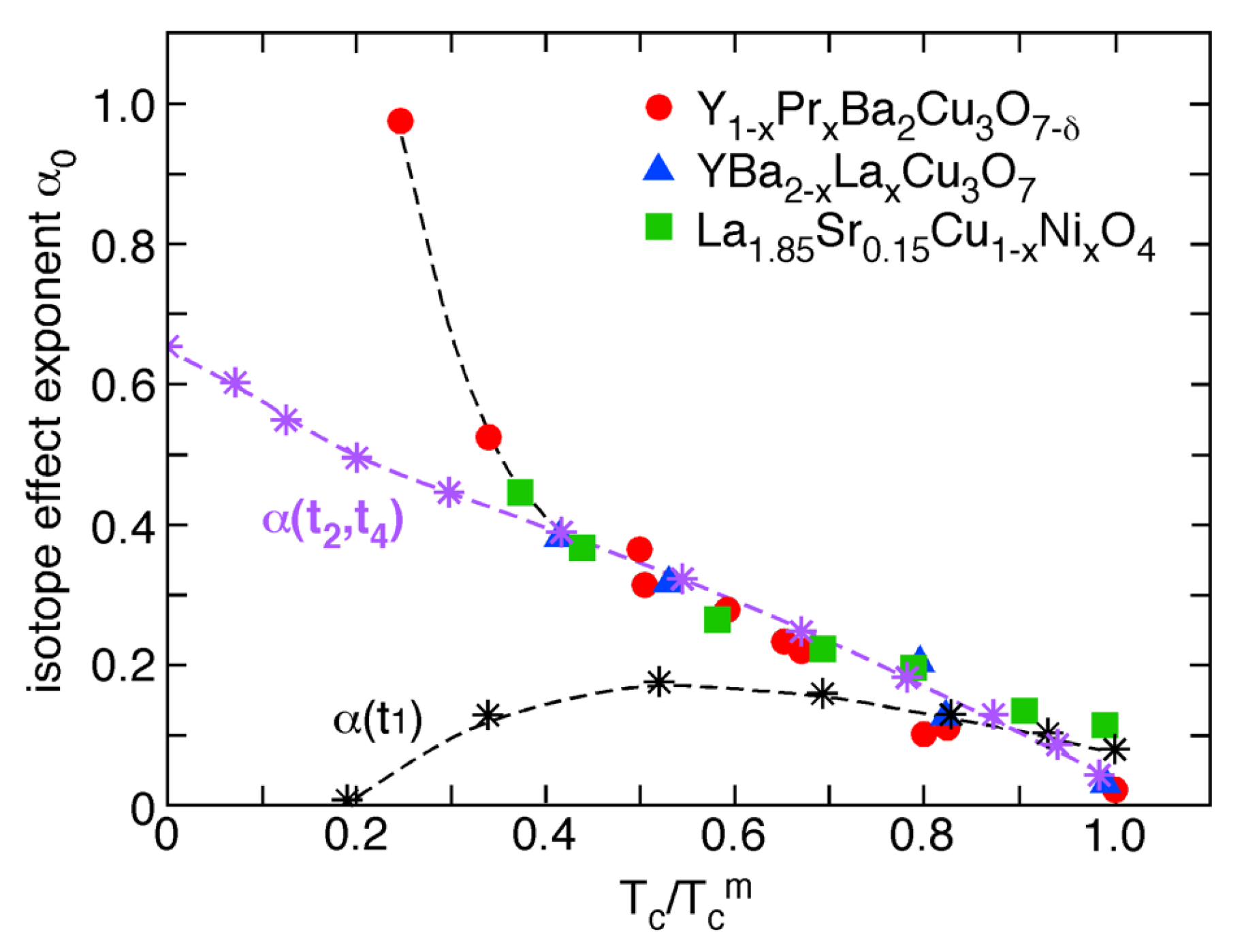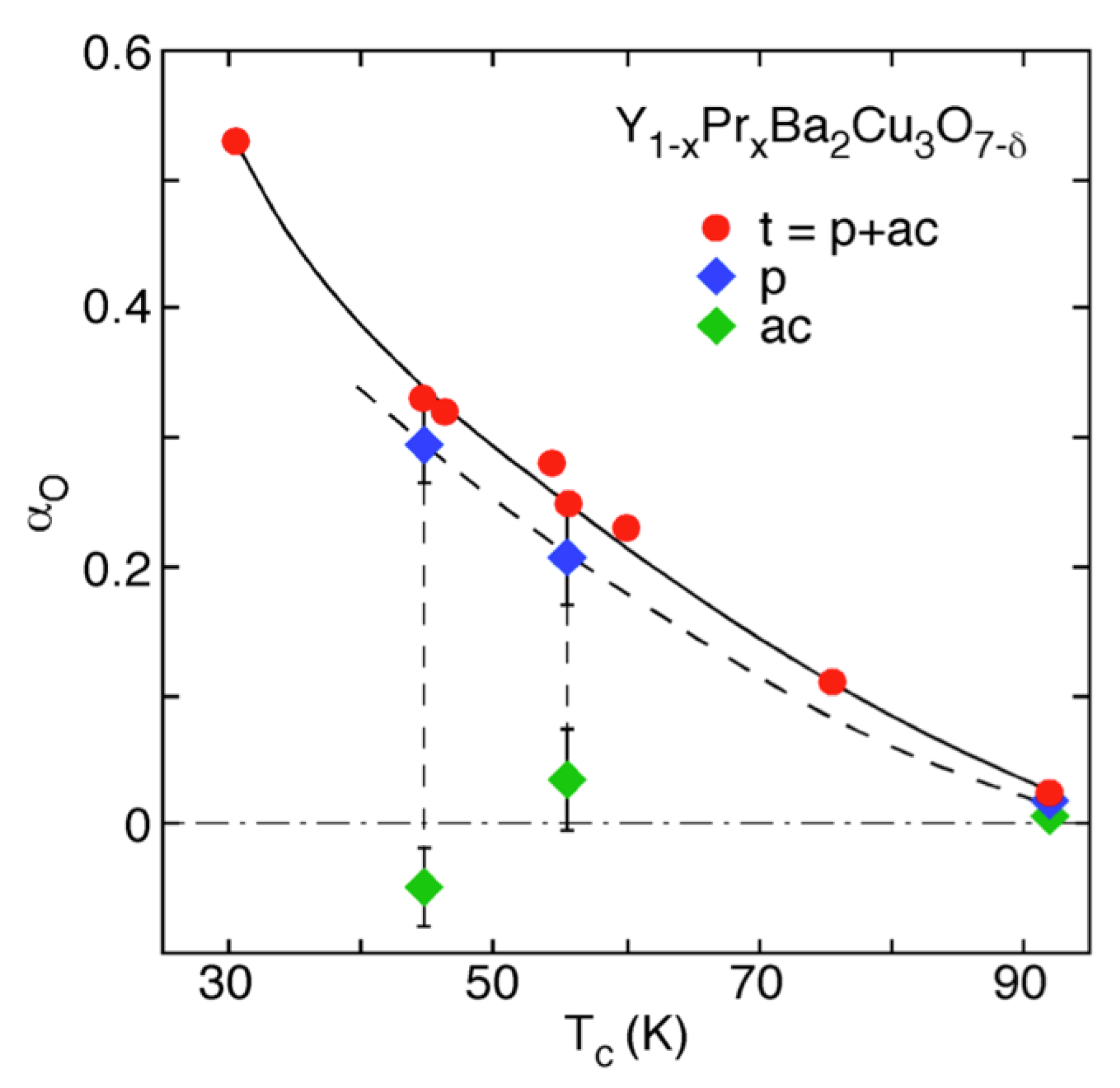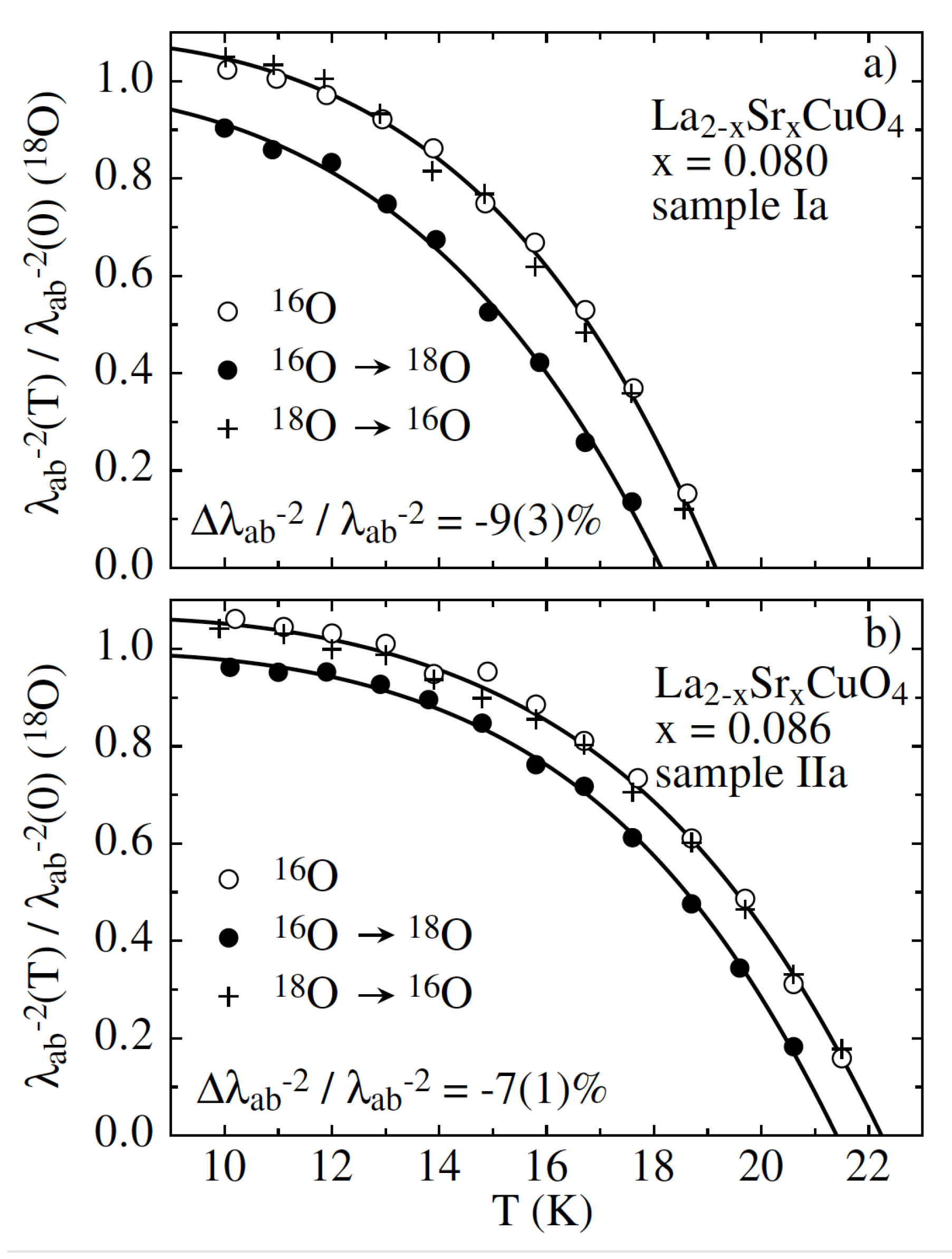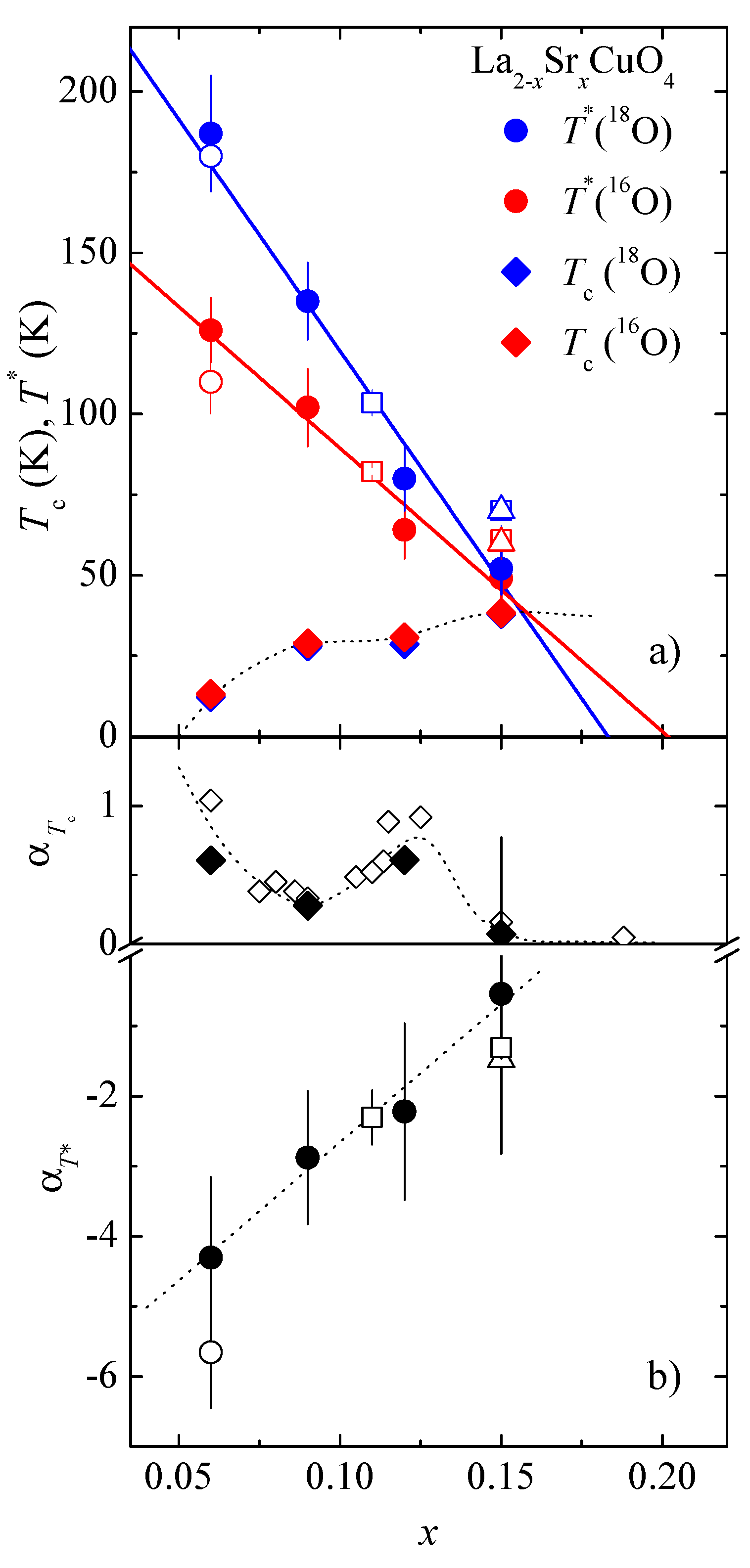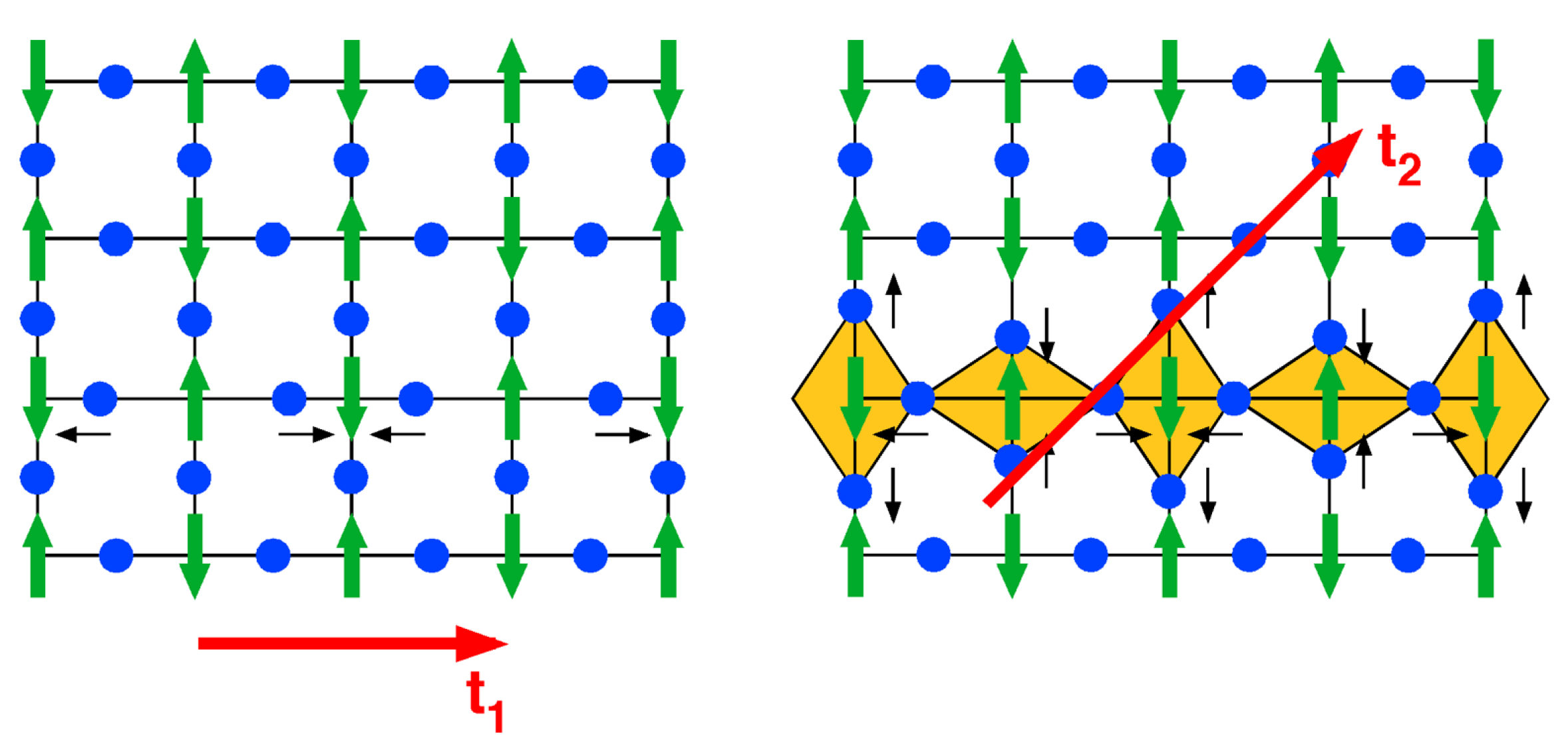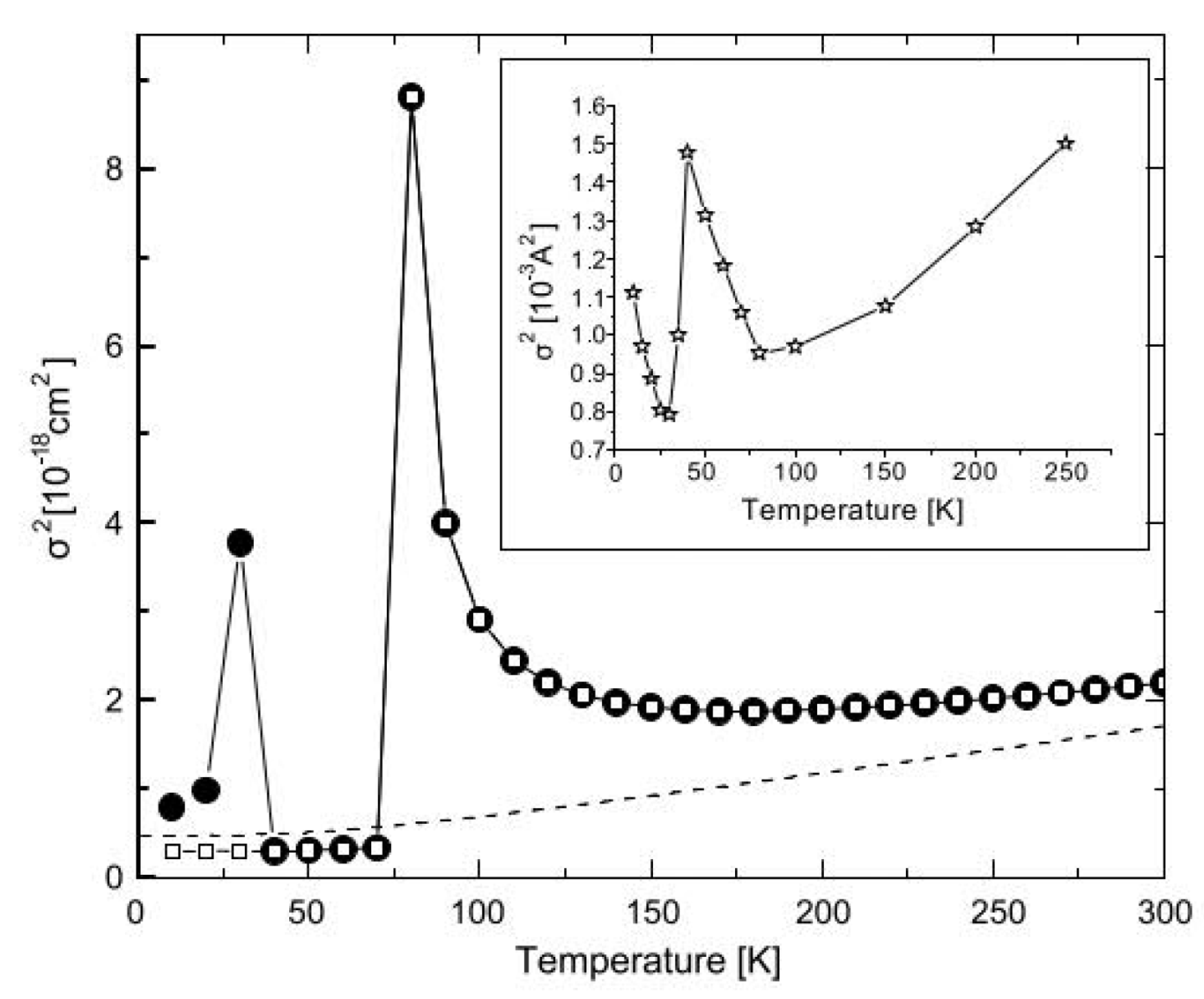2. Superconductiviy before 1986
As is well known, superconductivity was discovered in 1911, more than a century ago, by Heike Kammerlingh Onnes, together with his assistant, Gilles Holst, in ultra-pure mercury. This discovery was accidental and caused by curiosity, namely regarding the behavior of the resistivity of metals at low temperatures. Since Kammerlingh Onnes had made important progress to liquefy helium, he wished to determine which properties of metals can be explored at low temperatures. At that time, there were several theories predicting the temperature dependence of the resistivity of metals at ultra-low temperatures. In view of the inability to reach this temperature scale, the true dependence remained speculative only. Kammerlingh Onnes reached 4 K with He liquefaction and chose mercury for his experiments, since this was available in ultra-pure form, i.e., free of impurities. The major surprise was that the resistivity of Hg dropped to zero at 4.2 K, which was later named superconductivity. Kammerlingh Onnes received the Nobel Prize for Physics in 1913—not, as frequently believed, for the discovery of superconductivity, but for the liquefaction of the last gas, helium.
After this breakthrough discovery, further elemental metals were found to be superconducting as well, all in the low-temperature regime below 7 K. Only in 1933 was a further characteristic effect of superconductors discovered by Meissner and Ochsenfeld, who showed that superconductors expel a magnetic field completely from the interior.
Further important discoveries for the development of a theory for superconductivity by Bardeen, Cooper and Schrieffer (BCS) were the isotope effect and the concept of paired electrons, namely the formation of Cooper pairs. Both together were finally the basis for the BCS theory of phonon-mediated superconductivity [
2,
3].
In 1950, two independent research groups observed an isotope effect (IE) on the superconducting transition temperature
of mercury [
4,
5], which played a crucial role in the development of a theoretical microscopic model of superconductivity—in particular, of the weak-coupling BCS theory, where the electron–phonon interaction is the paring glue for Cooper pairs [
2,
3]. The isotope shift on
can be quantified by the following relation:
where
M is the isotope mass, and
is the IE exponent. In the framework of weak-coupling BCS theory,
with
. For many conventional superconductors, values of
were found (Pb:
, Hg:
, Sn:
). However, values much lower than 0.5 were also reported, e.g., Os (
) or Ru and Zr (
). Note, however, that a zero IE does not mean that no lattice effects are involved in the pairing. We come back to this important point later when we discuss isotope effects in cuprate superconductors.
In conclusion, the observation of an IE in conventional superconductors offers strong support of the concept of BCS theory, where the electron–phonon interaction leads to Cooper pairing.
3. The Jahn–Teller Effect
The discovery of high-temperature superconductivity by J.G. Bednorz and K.A. Müller [
1] was based on three important aspects related to cuprates and oxides: (1) Cu
is a strong Jahn–Teller (JT) ion; (2) superconductivity in oxides was rather rare; however, if found, their transition temperatures were unexpectedly high, despite the fact that the density of states was low and the ratio of phonon frequency versus Fermi energy close to one; (3) this observation led to the conclusion that the electron–lattice interaction is unusually large. The introduction of the JT polaron offered an explanation for the above and was taken as a possible route in the search for new oxide superconductors. For this reason, both the JT concept and the JT polaron are discussed in further detail in the following.
The JT effect was predicted and explained by Jahn and Teller at the Washington Physical Society Meeting in 1936 [
6,
7]:
As a general rule the electronic state of a polyatomic molecule can be degenerate only if the atomic configuration has a sufficiently high degree of symmetry. If the atomic nuclei are displaced the degenerate state may split up and if the splitting is a linear function of the displacement the original symmetrical configuration, and with it the original degenerate state, does not correspond to an equilibrium state of the molecule.The principal statement in this work is that stability of a molecule and electronic degeneracy are not possible simultaneously unless the molecule is linear. Therein, they consider all possible types of symmetry of the molecule by applying group-theory symmetrical rules (Jahn–Teller theorem, JTT): All non-linear nuclear configurations are therefore unstable for an orbitally degenerate state. This statement holds as long as the electrons contribute appreciably to the molecular binding. The central issue of the theorem is that ionic displacements and electronic motion cannot be decoupled, but form a novel vibronic state. This implies that the Born–Oppenheimer approximation fails in systems with JT active centers, and it is no more possible to separate the electronic wave function from the ionic one. This is very reminiscent of the polaron problem.
Early on, the group around H. Thomas suggested that a JT polaron might form in itinerant electron systems [
8] (Höck, Nickisch, and Thomas, HNT), which laid the groundwork for the discovery of cuprate superconductors [
1]. This theory will be discussed in more detail in the following. As already mentioned above, the JTT states that the interaction of an orbitally degenerate electronic state with the vibrational lattice modes destabilizes the lattice and leads to a lower symmetry of the latter, i.e., a structural phase transition. For a cooperative JT effect to occur, typically, insulators are considered, whereas HNT [
8] postulated that the JT effect might also occur in certain metals—the band JT mechanism. They considered a simplified case where a single electron with double degeneracy moves in a lattice where a strong electron–lattice interaction is present, meaning that the electron contributes to the binding of the molecule. The electron is allowed to hop from site to site and interacts with a symmetry-breaking lattice coordinate. This is in contrast to conventional electron–lattice coupling, where the interaction is caused by a fully symmetric one. The energy gain and JT stabilization energies proportional to the interaction divided by the lattice energy can reach substantial values. The case of interest for HNT [
8] is where the electronic band width and the JT energy are comparable. If the coupling is then strong enough, the electron becomes trapped, i.e., localizes, and only together with the surrounding lattice cloud can move in total through the lattice. A JT polaron is formed.
The study by HNT [
8] assumes that a molecular complex of tetragonal symmetry is realized in the crystalline unit cell with two-fold degenerate orbital states
at lattice site
l, which form bands of local doublets. Competition between electron transfer and localization arises when the electron–phonon interaction is switched on. Localization is realized for strong electron–lattice coupling, whereas, in the weak-coupling limit, band formation is favored.
In order to quantify these properties, the Hamiltonian
has to consist of at least three terms [
8]:
with
are electron creation and annihilation operators with
and site energy
.
t is the hopping integral, which is effective only for states of the same symmetry, i.e., inter-orbital hopping is neglected, in accordance with symmetry considerations. The lattice Hamiltonian
consists of the momentum
p and conjugate displacement coordinate
Q and an intersite potential
V, which couples nearest neighbor sites and accounts for an optic mode. Otherwise, any dispersion is suppressed, since an Einstein oscillator with frequency
is assumed. The electron–lattice interaction proportional to
g, as given by
, couples the electrons at site
l to the symmetry-breaking displacement coordinate at the same site. The Jahn–Teller energy
is typically much stronger than conventional electron–lattice interaction terms. The interesting problem of this scenario is realized when the Jahn–Teller energy
is of the same order of magnitude as the hopping integral
t, since, in this situation, it can be expected that the electron travels with its surrounding displacement cloud through the lattice, thus forming a JT polaron. The total object is characterized by its momentum
k and site index
l, which are replaced by a single index
l in the following in order to keep the equations more transparent. Introducing phonon creation and annihilation operators
, a trial translationally invariant wave function for the combined electron–lattice is given by:
where
A is a normalization constant, and
is the shape of the total deformation, whereas
a determines the form of the electron wave packet. Both quantities
A and
a are variational parameters.
The main results are that a wave packet of the form refers to localized states when its width is small and is located near the lattice site l with a deformation given by . This limit refers to . In the opposite limit, namely being small, the state corresponds to an almost freely moving electron, which is nearly unaffected by the lattice. However, if , then represents the combined electron–lattice bound state, where a momentum-independent electron couples to a phonon with momentum k. In order to obtain an approximate ground-state energy , minimization with respect to A and has to be carried through.
The above problem has been solved for a 1D chain where ion–ion interactions (
) are suppressed, the electron hopping is restricted to nearest neighbors and the lattice spectrum consists of an Einstein oscillator. The ground-state energy for the Jahn–Teller polaron is then given by:
with
being enlarged as compared to the bare electronic mass. Limiting cases of this simplified model yield, however, the relevant physics of the problem as outlined above, namely
. The distortion due to the coupling to the electronic motion is small and the electron motion through the lattice is almost unaffected, i.e., free-electron-like. With increasing JT energy, the distortion also increases, and for
, an isolated JT molecular complex results. The competition between localization and itineracy is thus an inherent property of the JT polaron problem.
One might ask, what is the distinction between the “conventional” Holstein-type polaron [
9,
10,
11] and the JT polaron [
8]? While, in the former case, a fully symmetric distortion pattern is formed, in the latter, a distorted lattice is involved. In addition, in the first case, electronic degeneracy is not a prerequisite, whereas, in the JT scenario, it is necessary, since the lifting of the degeneracy causes an important energy gain. Related to the Lang–Firsov transformation [
12], a variational ansatz is made, where analogous effects on the electronic and vibrational states are obtained—namely, the electronic wave function (kinetic energy) is exponentially renormalized by the lattice, whereas the lattice energy experiences a rigid shift due to the coupling to the degenerate electronic state.
With respect to cuprates, limitations of the applicability of the JTT are readily apparent: namely, the superconducting cuprates are doped materials. Correspondingly, the valency of the copper ion is not unique, but changes inhomogenously within the system. Thus, depending on the local copper valency, a JT effect might be possible or not. In addition, the changing valency of copper goes hand in hand with lattice responses, inducing locally distorted regions in coexistence with undistorted ones. From the above, the most important message is that heterogeneity coupled with lattice responses is intrinsic and essential to cuprate superconductivity. This aspect has been emphasized early on by K.A. Müller [
13], and, in conjunction with poorly understood experiments, he suggested that cuprates do not have a single
d-wave order parameter, but that two coupled-order parameters with
symmetry need to be considered [
14].
4. Heterogeneities and Mixed-Order Parameters in Cuprate Superconductors
Clear experimental evidence for intrinsic heterogeneity in the cuprates has been given by extended X-ray absorption fine structure (EXAFS) spectroscopy and pair distribution function analysis, where a stripe-like ordering of these regions has been detected [
15]. Again, it must be concluded that, in view of the symmetry lowering in the distorted regions, charge-rich areas and the fully symmetric undistorted charge-poor regions occur, where, in the latter, the efficiency of the JT effect as a global player is absent. However, the strong lattice responses observed experimentally cannot be ignored in a theoretical approach of cuprate superconductivity, and various suggestions have been made that polaron physics and bipolaron pairing scenarios are relevant for its understanding [
11,
16].
In the majority of the community, it is assumed that cuprate superconductors have a pure
d-wave order parameter (see, e.g., [
17,
18,
19]). However, based on experimental findings and theoretical considerations, K.A. Müller proposed that cuprate superconductors must have a mixed
-order parameter [
14,
20] (see above) that reflects the intrinsic inhomogeneities (hole-rich and hole-poor stripe-like regions) in these systems [
13]. In order to test this scenario, detailed muon-spin rotation (
SR) experiments on various families of cuprate superconductors were performed, since, with this technique, it is possible to directly measure the magnetic penetration depth (superfluid density) and its temperature dependence, which provides unique clues for
s-, respectively,
d-wave order parameters [
21,
22,
23].
The SR technique is a powerful and highly sensitive tool for investigating the magnetic properties of superconductors and magnetic systems. The positive muon (spin ) serves as a microscopic magnetic probe to detect local magnetic fields in the bulk of a solid, even with no external magnetic field applied (zero-field SR). This bulk sensitivity makes SR superior to APRES and STM, which are surface-sensitive and do not probe the bulk properties of the sample. We will discuss this important point later. Moreover, in contrast to most standard experimental techniques (e.g., neutron scattering, NMR, ARPES), SR allows us to determine the magnetic volume fraction in a sample, which is unique and of particular relevance for cuprates and related systems (e.g., coexistence of superconductivity and magnetism). SR has provided important information on the microscopic magnetic properties of these materials, which are difficult to obtain with any other experimental technique. Some examples are:
- -
Direct determination of the local magnetic field distribution and the magnetic penetration depth in type II superconductors;
- -
Study of the complex vortex-phase diagram (flux–lattice melting, 3D–2D crossover, vortex fluctuations) of cuprate superconductors;
- -
Coexistence of superconductivity and magnetism (magnetic phase diagram) in cuprate and iron-based superconductors;
- -
Detection of spontaneous magnetic fields (orbital currents) in the pseudogap phase of cuprate superconductors;
- -
Study of spin stripe order in cuprate systems.
SR is an ideal method to determine the pairing symmetry (
s,
d,
, etc.) of a cuprate superconductor in the bulk of a single-crystal sample by measuring the temperature dependence of the magnetic penetration depths (superfluid densities)
,
and
along the three principal crystallographic axes,
a,
b and
c. Such experiments were performed on three different cuprate systems, La
Sr
CuO
[
21], YBa
Cu
O
[
22] and YBa
Cu
O
[
23], in order to demonstrate that the observed behavior is generic for cuprates, which indeed was found to be the case.
As an example,
Figure 1 shows the temperature dependences of the
SR relaxation rates
,
and
of single-crystal YBa
Cu
O
[
22]. Note that
is consistent with a pure
s-wave order parameter, in agreement with
c-axis tunneling experiments [
24]. However, both
and
show a characteristic “up-turn” at a low temperature. A theoretical analysis of the data with a phenomenological model of a coupled
-wave order parameter [
25] reveals that, in the CuO
plane, a small
s-wave order parameter (small gap) coexists with a dominant
d-wave order parameter (large gap); the contribution of the
d-wave gap to the total in-plane superfluid density is ≈75% [
22]. This behavior is generic for all cuprate superconductors investigated [
21,
22,
23], and also manifests the intrinsic inhomogeneity of the cuprates [
13,
26].
Several experimental studies using various techniques (e.g., ARPES, phase-sensitive tunneling experiments, NMR,
SR, magnetization experiments, etc.) were conducted to test the pairing symmetry in cuprate superconductors. However, controversial results concerning the gap symmetry (
d,
s,
) were obtained [
20]. This is due to the fact that some techniques (ARPES, phase-sensitive tunneling, etc.) probe the gap symmetry near the surfaceof the sample, whereas other methods (
SR) probe the order parameter in the bulk of the sample. Based on these experimental findings and group theoretical considerations, K.A. Müller [
26,
27] proposed that the order parameter has a mixed
symmetry, changing from a dominant
d-wave character near the surface to a more
s-wave character in the bulk of the superconductor. This scenario of coexisting
order parameters is clearly supported by recent AC magnetization and
SR studies of the in-plane (
) and out-of-plane (
) magnetic field penetration depths near the surface and in the bulk of the electron-doped cuprate superconductor Sr
La
CuO
[
28].
6. Unconventional Isotope Effects in Cuprate Superconductors
The discovery of high-temperature superconductivity in the cuprates [
1] with transition temperatures
, much higher than for conventional low-temperature superconductors, raised some fundamental questions: What is the origin of the electron–hole pairing mechanism in these superconductors? Is it the electron–phonon pairing as in conventional superconductors, or are purely electronic effects at play? In order to explore the origin, an oxygen (
O/
O)-isotope effect (OIE) study in optimally doped YBa
Cu
O
was performed in 1987, but no appreciable OIE on
could be detected [
32]. From this finding, the majority of researchers concluded erroneously that the electron–phonon interaction, or, more generally, lattice effects, are not responsible for superconductivity in the cuprates, and alternative models—mainly of purely electronic origin—were proposed to explain the high-temperature superconductivity in the cuprates. Consequently, lattice effects were almost completely ignored. However, soon after the first OIE study [
32], it was demonstrated that all cuprate superconductors exhibit a finite OIE on
at all doping levels, increasing substantially with reduced doping (see, e.g., [
33,
34]), which is a generic trend, as shown by the examples presented in
Figure 3. These IE results clearly indicate that lattice effects are essential to understand the basic physics of cuprate high-temperature superconductors.
Having the JT polaron concept in mind, K.A. Müller was convinced early on that the isotope effect also plays a vital role in understanding the nature of high-temperature superconductity in the cuprates [
35]. Consequently, in 1990, he initiated a new project, “Isotope Effects in Cupate Superconductors”, at the University of Zurich [
36,
37,
38,
39]. The primary aim of this project was to perform a so-called site-selective oxygen isotope effect (SOIE) study on
in optimally doped YBa
Cu
O
[
40]: Which oxygen atoms (planar (p), apical (a) or chain (c) oxygens) in the lattice contribute most to the OIE shift of
? The results of this investigation, together with complementary SOIE studies of Y
Pr
Ba
Cu
O
(
) [
41,
42], are displayed in
Figure 4. It is obvious from the figure that, for all doping levels
x, the main contribution (≥80%) to the isotope shift of
arises from the oxygen atoms in the CuO
planes. This is opposite to what was expected by K.A. Müller in his original proposal, where he attributed large anharmonicity to the apical oxygen ions and a major contribution of them to the OIE on
[
35].
Besides the OIE and SOIE on
discussed above, doping-dependent unconventional OIEs were also observed on various physical quantities, such as the magnetic penetration depth
, the spin-glass transition temperature
, the spin-stripe ordering tempertaure
and the pseudogap temperature
[
36,
37,
38,
39,
43,
44,
45]. In the following, we only discuss the OIEs on
and
, which both demonstrate the polaronic character of the supercarriers in the cuprates.
In weak-coupling BCS theory (Migdal adiabatic approximation), the effective mass
of the supercarriers is independent of the mass
M of the lattice atoms. However, in the JT polaron concept, the adiabatic approximation is no more fulfilled, and
depends on
M. A direct test of this is the observation of an IE on the magnetic penetration depth
, which is absent in a weak-coupling BCS superconductor. For a cuprate high-temperature superconductor, the zero-temperature in-plane magnetic penetration depth
is given by [
36]:
where
is the superconducting carrier density and
is the in-plane effective mass of the carriers. It is convenient to express the OIE on
in terms of the in-plane superfluid density
, yielding:
This implies that any OIE shift of the superfluid density arises from an OIE shift of and/or .
OIE studies of the magnetic penetration were performed on a number of families of cuprates by means of different experimental techniques (magnetization measurements, torque magnetometry, muon-spin rotation (
SR)) and on various kinds of samples (fine-grained powder samples, microcrystals, thin films) (see, e.g., [
36,
37,
38,
39]). All these studies show a clear OIE on the magnetic penetration depth, which increases with decreasing doping (decreasing
) for all investigated cuprates. As an example, we show in
Figure 5 some of these results obtained on microcrystals of underdoped La
Sr
CuO
(
) using high-sensitivity torque magnetometry [
46]. A large OIE on the in-plane magnetic penetration depth
was detected:
for
and −7(1)% for
, respectively [
46]. Moreover, a site-selective OIE (SOIE) study of
in underdoped Y
Pr
Ba
Cu
O
revealed that the planar oxygens mainly contribute (
) to the OIE shifts of
and
(see also
Figure 4) [
42].
For comparision, the boron isotope (
B/
B) effect on
and the magnetic penetration depth
were also investigated in the conventional two-gap superconductor MgB
[
47]. As expected, a substantial isotope effect on
was observed, but no isotope effect on
could be detected in this BCS-type superconductor.
It is generally accepted that the pseudogap temperature
plays a crucial role in understanding the complex physics of cuprates. However, from an experimental point of view, the temperature
is ill-defined. It is more a “crossover temperature” rather than a phase transition temperature, and depends on the time and length scales of the experimental technique (see, e.g., [
48]). Here, we define
as the temperature where deviations from the average local structure set in (charge ordering or charge-stripe ordering temperature). Note that, for this definition of
, magnetic effects are unimportant. Thus, a possible OIE on
reflects the presence of lattice/polaron effects. Up to now, several studies on the OIE on
on different cuprate systems have been performed by means of X-ray absorption near-edge structure (XANES) studies [
48,
49] and neutron crystal-field spectroscopy (NCFS) studies [
50,
51,
52,
53,
54]. All these studies show a large negative OIE on
. The results of all present OIE studies of
and
of La
Sr
CuO
obtained by XANES [
48,
49] together with the NCFS results for La
Ho
Sr
CuO
[
53,
54] are presented in
Figure 6. Note that the OIE exponent
is sign-reversed to
and increases almost linearly from
to −0.6 with increasing doping
x. On the other hand, the doping dependence of the OIE exponent
shows the characteristic behavior with the anomaly at
(
Figure 6). Moreover,
decreases linearly with increasing
x with different slopes for
O and
O (see
Figure 6a). The limit
is tentatively identified as a “quantum critical point
” [
55,
56]. Since
exhibits a pronounced OIE [
48], this “special point” thus cannot be of purely electronic origin, as widely assumed.
Furthermore, additional NCFS studies of the
Cu/
Cu isotope effect of
in double-layer HoBa
Cu
O
[
52] and in single-layer La
Ho
Sr
CuO
[
53] revealed a large negative isotope shift of
for the double-layer compound, but no isotope shift for the single-layer compound. Whereas oxygen and copper JT-type modes are both relevant for the double-layer compound, the so-called umbrella-type copper modes are absent in the single-layer compound, consistent with the observed oxygen and copper isotope effects on
[
53].
A theoretical explanation of the above-described IE has been given in [
43], where the renormalizations of the hopping integrals through polaron formation have been investigated in detail. In order to reproduce the band structure of cuprates with a minimum model, the nearest (
) and second nearest (
) neighbor hopping together with the interplanar (
) one are sufficient [
57]. Their exponential narrowing has been treated variationally and as a function of isotopic replacement. As depicted in
Figure 3, only
and
contribute correctly to the IE, whereas
is counterproductive. By combining these results with the corresponding lattice displacements (
Figure 7), it is apparent that only the
-type lattice mode is essentially involved in the OIE, thereby confirming the original viewpoint of JT polaron formation. Note that the interplanar hopping
plays an important role in the correct derivation of the OIE on
(see
Figure 3), and thus demonstrates that the CuO planes are not the only relevant structural elements for HTSC, but that the interplanar coupling (3D) needs to be included as well.
In the following, we concentrate on the correlated effect arising from the lattice degrees of freedom and evaluate its response to polaron formation. Since the above-described isotope experiments support directly the eminent role played by the lattice, it is of importance to see which effects result in the lattice response. Polaron formation has coupled consequences for the electronic and lattice degrees of freedom. While, as pointed out above, the electronic hopping is renormalized by it, the lattice displacements experience a rigid, electronically induced shift. This means that the lattice-related Hamiltonian transforms to [
12]:
with
where the momentum
q and branch
j-dependent renormalized frequencies
are given by [
58,
59]:
with
being the Fourier transform of the site representation and
the bare unrenormalized frequency. The coupling to the electronic degrees of freedom introduces an important temperature-dependent softening of this coupled mode, which is no longer a pure lattice mode, but represents the combined distortion of lattice and electronic degrees of freedom. The momentum
k-dependent electronic dispersion is given by:
where
,
and
account for the hopping integrals defined above, and
is the chemical potential, which controls the band filling. Below
,
has to be replaced by
, where
is the superconducting energy gap, which can be of
d-wave or
s-wave symmetry, or be represented by a mixed
-wave order parameter, as suggested from
SR experiments [
21,
22,
23] discussed above (see
Figure 1). As mentioned above,
gains a substantial temperature dependence due to its coupling to the charge and softens with decreasing temperature at finite momentum
q, which defines the periodicity of a modulated structure [
58,
59]. When this softening is complete, a dynamic superstructure in the polaron spatial distribution appears, which we identify here with the so-called stripe pseudogap phase [
60,
61]. Within this description, the onset temperature
is determined by the coupling constant
and the energy of the unrenormalized mode frequency
, which is given by the following implicit relation:
is the relevant control parameter, which systematically grows upon approaching the underdoped regime, where localization sets in and a metal to insulator transition takes place. Note that the pseudogap temperature
is isotope-dependent through the coupled effects of the isotope dependence of the bare lattice frequency and the polaronic renormalizations of the band energies. The isotope effect on
is sign-reversed as compared to the one on
, and it is huge, in full agreement with the XANES and NCFS experiments presented above (see
Figure 6), demonstrating the importance of polaron formation. Above
, the polarons are transient, dynamic and randomly distributed over the lattice forming around the doped hole, since the extra charge introduced by doping induces a local lattice distortion, which is tied to this charge. At high temperatures, the dynamics of these objects exhibit rather high frequencies. Upon approaching
, their dynamics slow down and are almost frozen at
. Below
, the polarons become persistent, but are still dynamic with high frequencies and confined to the new patterned modulations, which are determined by the momentum at which the local dynamics freeze in. The relative mean square displacement
of the copper–oxygen distance [
58,
59] as a function of temperature for
and
K is shown in
Figure 8.
The filled black circles/open black squares refer to an
s-wave and a
d-wave order parameter, respectively. For comparison, the bare unrenormalized mean square displacement (
) is added (dashed line). The inset shows the experimental data for La
Sr
CuO
[
62]. Note that, in the calculations, no damping or artificial line width broadening was introduced in order to minimize the number of parameters. As is apparent from
Figure 8, the experimental data can only be reproduced by including an
s-wave order parameter that correctly models the dip/hump structure below
and is absent in a pure
d-wave scenario.
